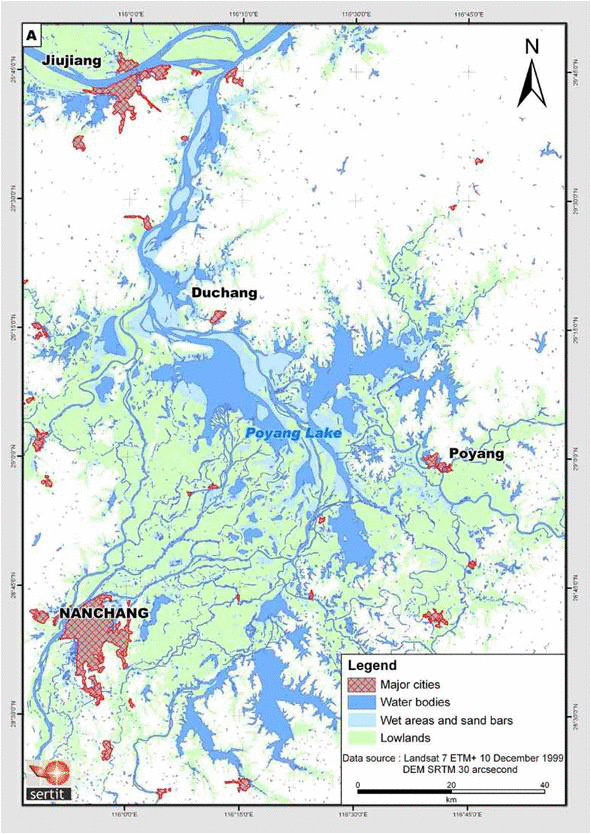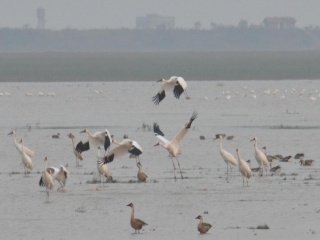Posted 08/9/10
James Burnham studies Poyang Lake, China's largest freshwater lake, and one of the country's most important wintering areas for hundreds of species of migratory birds, including the critically endangered Siberian Crane. He seeks to understand how complex seasonal water fluctuations, together with recent human impacts, affect the native flora and fauna. Understanding of the interplay of human, animal, and environmental effects on the lake is critical to achieving a balance between conservation and the needs of the ever growing and resource-dependent human populations in and around the lake, as well as China as a whole.
It’s as close to a natural fact as there is – places that are useful to humans are also useful to a wide variety of plants and animals. The conflicts that can result from a mutual desire to utilize limited resources are perfectly exemplified in southeast China’s Poyang Lake region. Is there any way to reach a balance that is mutually beneficial to both animals and humans? SILVIS lab member and Ph.D. candidate James Burnham is laying the foundation that may contribute to a solution. style=text-align:”>

Poyang Lake is a complicated ecosystem, with huge changes in lake depth and extent depending on the season and the year. Typically, these changes follow a pattern of being low during the winter months, and high in the summer. The International Crane Foundation (ICF) has maintained a long-term ecological monitoring program starting in 1998, which sought to better understand the dynamics of the lake system and learn more about how the critically endangered Siberian Crane, and other waterbirds, used the lake. Initially, this monitoring was set up in partnership with Poyang Lake National Nature Reserve to determine the relationships between fluctuating water levels, waterbirds and the plants they forage on, but initial analyses did not reveal conclusive trends between the Siberian Cranes and their food source.For his M.S. thesis, Burnham filled in some of the gaps in the ICF study by intensifying the sampling effort and focusing on one particular component of the monitoring: how Siberian Cranes choose foraging sites based on water depth and accessible vegetation. The prevailing hypothesis was that cranes would chose sites where their favorite food, the tubers of Vallisneria, was abundant.Burnham found that the relationship between Siberian Cranes and Vallisneria was more complex than that. The cranes really needed both abundant tubers AND shallow waters where the roots and tubers of Vallisneria can be reached.
Initially, this monitoring was set up in partnership with Poyang Lake National Nature Reserve to determine the relationships between fluctuating water levels, waterbirds and the plants they forage on, but initial analyses did not reveal conclusive trends between the Siberian Cranes and their food source.For his M.S. thesis, Burnham filled in some of the gaps in the ICF study by intensifying the sampling effort and focusing on one particular component of the monitoring: how Siberian Cranes choose foraging sites based on water depth and accessible vegetation. The prevailing hypothesis was that cranes would chose sites where their favorite food, the tubers of Vallisneria, was abundant.Burnham found that the relationship between Siberian Cranes and Vallisneria was more complex than that. The cranes really needed both abundant tubers AND shallow waters where the roots and tubers of Vallisneria can be reached.

This is an important finding, when you consider how humans have utilized the lake in the past, and intend to use it in the future. Ponds created during the low-water winter period are increasingly used for crab farming, which may remove the plant life upon which the cranes depend. Crab farming also dramatically harms the traditional fishing practices of human communities around the lake, who are just as dependant on a healthy ecosystem as the critically endangered crane. There are also plans in the works for a dam near the outlet of the lake, which would permanently raise water levels in the winter, preventing the birds from accessing the vegetation they need for winter forage.

Now, for his Ph.D thesis, Burnham is taking things a step further. He is working to build a complete ‘foraging habitat’ model of the lake, incorporating density of Vallisneria and water depths during the winter season when the Siberian Cranes rely on the lake. He also wants to include the impacts of weather, interactions with other migratory bird species, and human disturbance patterns at multiple scales across the lake basin. All these things will give scientists a greater understanding of the complex, interconnected ecosystem of the lake, and particularly the role that Siberian Cranes play. ‘For me, this project started out being about the Siberian Cranes,’ says Burnham. ‘But it turned into a project that was more about the lake. It wasn’t long before I realized what a unique system Poyang is and that to conserve the last wild population of these cranes we really need to conserver the ecology of the lake.’ For further information about Poyang Lake, bi-lingual reports and recommendations to policy makers and the International Crane Foundation’s activities in the region please go to www.savingcranes.org/poyanglakeproject.html style=”text-align: center;”> “
“
Story by Nicholas Keuler
